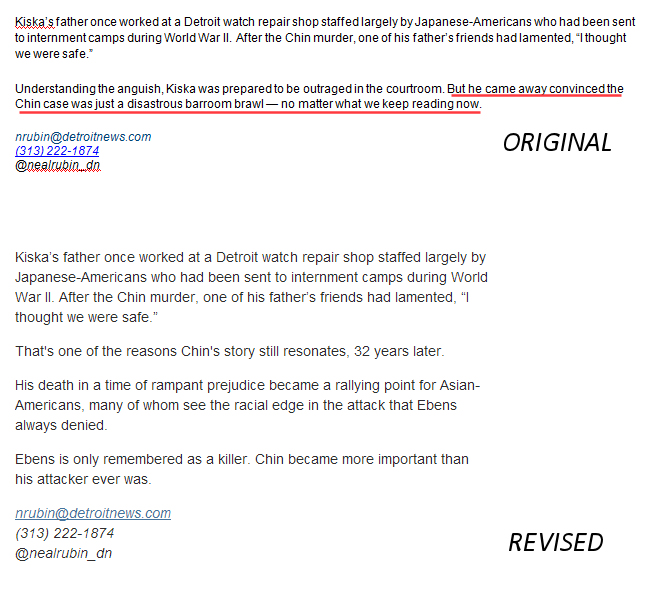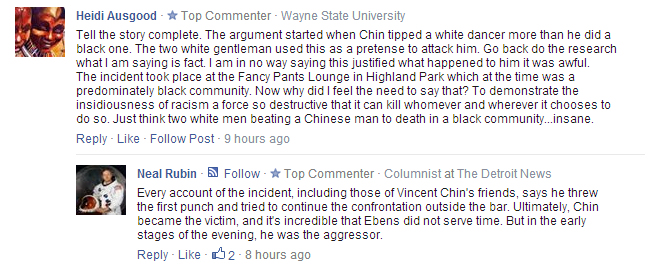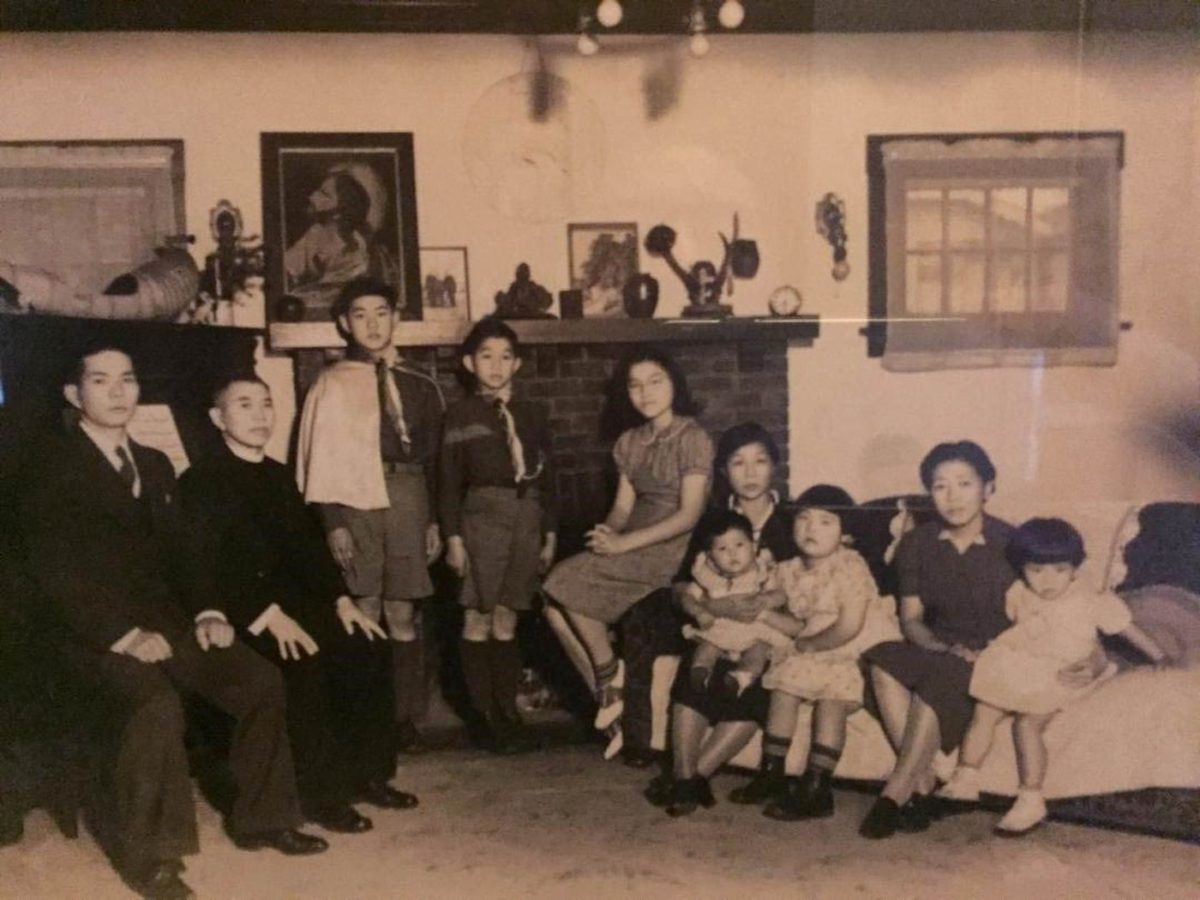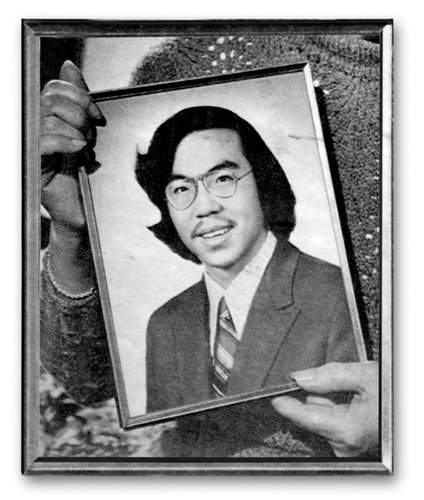
Published days before 2014’s Asian American Heritage Month opens, Neal Rubin (@nealrubin_dn) of the The Detroit News (one of the city’s conservative papers) has written one of the most bizarre, incoherent and irresponsible stories to-date on the Vincent Chin murder. (Note: Rubin and/or his editors have since made numerous changes to the story; thanks to reader @DorisTruong for pulling a cached version that appeared prior to the edits, .pdf)
Vincent Chin’s brutal death at the hands of Detroit auto workers Ronald Ebens and Michael Nitz 32 years ago remains a watershed moment in Asian American history. Faced with the unmistakable evidence that Chin’s killing was a racially motivated hate crime, Asian Americans across the nation united across ethnic boundaries to seek justice for Chin’s murder.Despite these efforts, both killers were sentenced to no jail time and a minimal fine for their parts in Chin’s death.
Under the headline “What we all assume we know about the Vincent Chin case probably isn’t so“, Rubin rejected the documented facts. Instead, he penned today an alternate history: a weird screed so sensationalized, incoherent, and libelous that it seems more appropriate for the pages of a tabloid magazine than a newspaper of any repute. In so doing, Rubin reopens for Asian Americans the painful memory of a traumatizing miscarriage of justice, and pours salt into the wound with unfounded hearsay.
To say that the Asian American community is outraged would be an understatement.
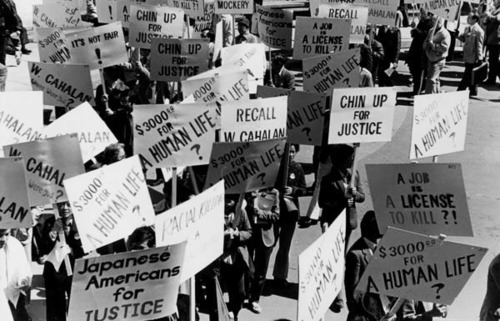
Scholars of Asian American history will remember the critical details of Chin’s death: Chin was at the Fancy Pants gentleman’s club with his friends for his bachelor party on the night of his beating. A fight broke out in the club between him and Ebens and Nitz, and all were ejected. Later, Ebens and Nitz armed themselves with a baseball bat from Ebens’ car, and stalked Chin to the parking lot of a nearby McDonald’s. There, the two White men beat Chin to death. During the subsequent trial, Ebens and Nitz faced hate crime charges supported by witness testimony that the two men were upset on the night of Chin’s death over competition between Japanese and American auto manufacturers that had led to many layoffs in Detroit including Nitz’s, and further that they uttered racial slurs during the fatal beating.
Rubin’s alternate history — ostensibly presented as a refutation to an off-the-cuff reference to the Chin murder in an unrelated article in The New York Times — is based on three counter-points to the accepted narrative of Vincent Chin’s death, virtually none salient. First, Rubin refutes that Chin’s death was related to the flagging Detroit auto industry, writing:
Neither [Ebens nor Nitz] was unemployed, however, one worked for a furniture chain, and the only testimony connecting the crime to fury over the auto industry was so dubious that a jury in a federal civil rights trial rejected it.
According to Rubin, Chin’s blood alcohol level that night — 0.14 — is also relevant (heaven forbid a man imbibe drinks during his bachelor party!), as is the fact that Ebens and Nitz’s trial judge was a prisoner of war under the Japanese Imperial Army during World War II (as if this somehow refutes characterizations of the outcome of the trial as a miscarriage of justice). As for the “dubious” witness testimony linking Ebens and Nitz’s crime to the auto industry, Rubin spends several paragraphs on prurient finger-wagging against witness Racine Colwell, who worked at the Fancy Pants Lounge and whose testimony served as a basis for the hate crimes charges. But, according to Rubin:
It was in the federal trials that a bottomless dancer named Racine Colwell claimed that Ebens had snarled, “It’s because of you (bleeps) we’re out of work.”
Colwell arrived in court in Detroit without underwear. Prosecutors had to scramble to find her a topcoat.
“Forget about the underwear,” Kiska says. “She was so wacky, so out to lunch, it was hard to believe her.”
Her testimony is the source for what’s now accepted as the truth.
This prurient refutation of Colwell’s testimony is as bizarre as it is irresponsible, seeming to hinge upon the unspoken and titillating assertion that either sex workers or women who choose to go commando (or both?) are automatically inclined to commit perjury when offering testimony in a court of law. Racine Colwell wasn’t wearing underwear? She is clearly a liar.
Neither Ebens and Nitz’s employment status nor Chin’s blood alcohol content refute the argument that a hate crime took place that night, and Judge Kaufman’s time in a Japanese prison camp seems immaterial. Thus, what Rubin achieves with his article is to muddy the waters with sensationalized gossip over Racine Colwell’s panty status, and seasoned with a heavy dose of largely irrelevant information.
And why? Because, writes Rubin, apparently what “we” believe about the Vincent Chin murder is incorrect. But, it seems clear that the “we” of Rubin’s piece are people who didn’t care enough about the Vincent Chin case to get the facts straight in the first place. Rubin’s “we” may well be a royal usage referencing Rubin himself (and in that, I agree — Rubin obviously has made some poor assumptions about the Vincen Chin murder), but his “we” clearly does not encompass the vast majority of Asian Americans.
In truth, we, Asian Americans, have never painted a glorified image of Vincent Chin that omits the fact that he was drunk on the night of his death or that he may have thrown the first punch. We have never asserted that Ebens and Nitz were both unemployed.

We, Asian Americans, have consistently maintained that the circumstances of Chin’s death are complex; but, we have also further asserted that a bar brawl gone awry does not mitigate the fact of Chin’s subsequent beating as racially charged retaliation on the part of Ebens and Nitz. That Chin threw the first punch in the Fancy Pants Lounge does not excuse Ebens and Nitz hurling racial slurs at Chin in the club. That Chin challenged Ebens and Nitz to a fight upon ejection of the club does not refute that Ebens and Nitz armed themselves with a baseball bat and paid a man $20 to help them track Chin down after he ran away. That Judge Kaufman spent time in a Japanese prison camp does not justify an impossibly lenient sentence for the racially motivated taking of a human life.
Rubin’s article is irresponsibly bad journalism that cherry picks the facts based almost exclusively on the opinions of reporter Tim Kiska, who covered the original Ebens and Nitz trial. Rubin writes in his own comments section that he has wanted to point “this” out at least a half dozen times in regards to Chin’s case; apparently, writing a piece to blame the victim in Vincent Chin’s death (or at least to paint him as the aggressor) has been a burning desire of Rubin’s for some time now.
Rubin’s article asserts that Chin’s actions earlier in the evening are critical information for understanding his subsequent murder. He argues that Chin’s decision — to meet racial epithets hurled in his direction with force — are neither understandable nor excusable. Rubin believes instead that the blame for Chin’s death should be spread if not evenly between all players, at least shifted more in Chin’s direction. If only Chin had not acted “aggressively” against Ebens and Nitz he might not have been killed. If only Chin had been more well-behaved. If only Chin had known his place.
It’s absolutely true that we shouldn’t believe everything written about the circumstances of Chin’s murder. And, Neal Rubin’s lazy writing seems to be one of those things.
Update (4/30/2014 9:45AM): The Asian American Journalists Association (AAJA) has released a statement condemning Rubin’s piece for a failure to achieve “fair and accurate journalism”, and are calling on The Detroit News to work with them in discussing Rubin’s column. Here is a link to their full statement.
Also, it has come to my attention that Rubin has since the publication of his original piece and this response been wildly changing his original article. The version of Rubin’s piece that now loads at this link differs significantly from the version that I read in formulating this response; while much of the points remain, the article has been re-written and polished in terms of tone and language. There has been no indication in the article that it has been modified since its original publication; failure to inform readers that the article has been altered since its original publication is itself an example of poor journalism.
If anyone has knowledge of how to pull a cached version of the article from April 29th, that would be most helpful.
Stay tuned to this post for more updates as they unfold.
Update (4/30/2014 10:00AM): UC Hastings law professor Frank Wu (@FrankHWu) weighs in. Also, an earlier version of this post had mispelled Judge Kaufman’s name.
Update (4/30/2014 10:00PM): Asian Americans Advancing Justice-Los Angeles (@AAAJ_LA) issues a statement, as does the Asian Pacific American Affairs Commision of the state of Michigan.
Update (5/1/2014 12:00PM): Thanks to the work of reader @DorisTruong, the cached original of Rubin’s piece is now available (.pdf). The chief difference is in the final paragraphs, which in the original was tantamount to arguing that Chin’s murder was the outcome of a barfight (in which Chin was the agressor, the piece argues earlier) gone horribly wrong.
